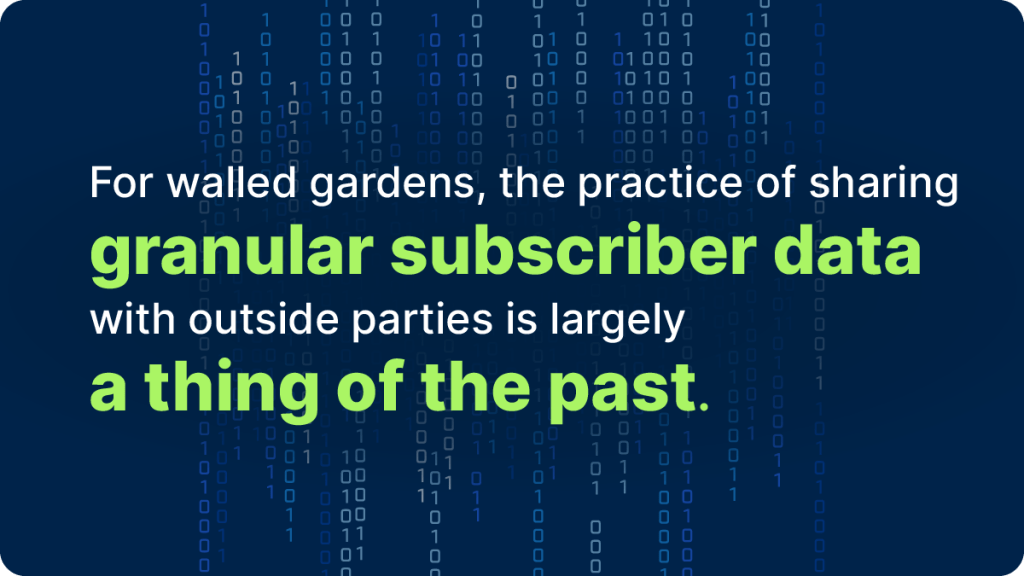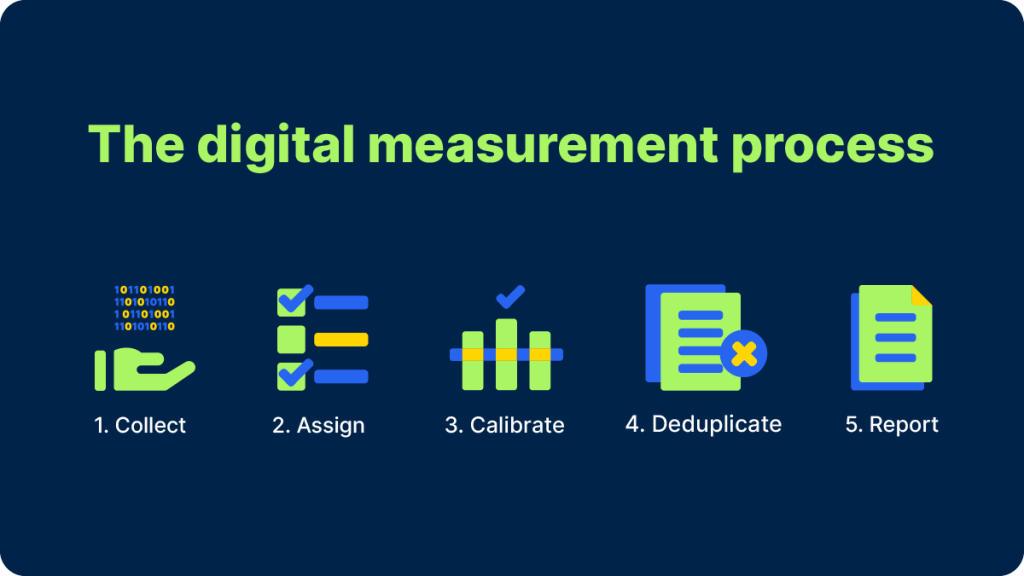How does digital measurement compare to TV measurement?
In a lot of ways, it’s similar: It involves panels, big data and technology to capture what people are doing online and who they are. As with TV, publishers use measurement to gauge the popularity of their content and value their ad inventory, and advertisers use it to verify that their campaigns are running and reaching their intended audience at the right frequency1.
While the basic principles and ultimate objectives of TV and digital measurement are similar, the tools, processes and ecosystem involved are very different.
Let’s dive in to understand the nuances of how to measure digital audiences and campaigns.
What do we mean by ‘digital measurement’ anyway?
At the most basic level, digital measurement means monitoring a user’s exposure to ads and content delivered over the internet. When we talk about digital measurement in the media industry, we generally focus on two dominant digital experiences: walled gardens and the open web.2

The key difference between the two is that walled gardens restrict access to their first party data—you know, like a garden locked behind a wall—and the open web does not. Social media sites are an example of walled gardens, whereas sites and apps like Weather.com, Words With Friends and CNN are part of the open web.
This is an important distinction for measurement purposes: Technically, a walled garden should have a pretty clear idea of who is accessing content and seeing ads on its platform. But if other companies want to measure their ad or content consumption within these walled gardens, generally, they have to build custom integrations that are compliant with privacy regulations.
While websites on the open web can have robust and authenticated first party data, it’s not always a given. In those cases, general websites often rely on proxy IDs and other adtech solutions to identify, target and measure users.
Current industry challenges
On the open web, the ongoing deprecation of third-party cookies and device IDs is making it more difficult to identify users and is forcing stakeholders to rethink their measurement approach. Apple’s decision in 2021 to change default app tracking permissions (from opt-out to opt-in) wiped out three-fourths of IDFAs (Apple’s mobile ad IDs) from consideration. And Google is scheduled to phase out third-party cookies in the second half of 2024, the final blow to an ID system that held up for the most part, but was always an imperfect solution. Cookies aren’t people, after all.

For walled gardens, the practice of sharing granular subscriber data with outside parties is largely a thing of the past, even for anonymized measurement purposes. To comply with major data global privacy regulations, walled gardens are now sharing activity data with advertisers and measurement companies in aggregate form, if they’re sharing it at all.
Those are serious challenges for measurement that have forced the industry to look elsewhere for consumer identifiers, signals and attributes. And it all starts with an impression.
What’s a digital ‘impression’ exactly?
Before we get into the details of what a modern digital measurement process looks like, let’s spell out what an impression is.
Impressions measure the number of times an ad or piece of content was delivered to a digital device. While impressions give you the total volume of exposure to your ad or content, it does not measure how many people actually saw it. (That’s reach.) So, for example, if five people saw your LinkedIn ad twice, that means your campaign impressions would be 10.
Current digital media viewability guidelines to qualify an impression stipulate that an ad must be at least 50% in focus on the user’s screen—not hidden behind another window, for example, or playing in the background—for at least 1 second for display ads and 2 consecutive seconds for video ads. Impression time and viewability thresholds now provide a robust foundation for advertisers and publishers to set the terms of their media transactions.
Now that we understand what digital activity we’re measuring, let’s get into how we measure it.
5 key steps in the digital measurement process
At Nielsen, we look at digital measurement as a five-step process:

Step 1: COLLECT
The first step in the process is to make sure that the content and ads data is all properly captured and identified. For web content, a page URL is an acceptable identifier, but there might be multiple ads on a single url that will need to be uniquely identified. For content measurement, clients’ integrate Nielsen’s SDK3 within their websites or apps. For ads measurement, we either use direct integrations with publishers, or ask advertisers or their agencies to integrate Nielsen tags in their ads when they traffic campaigns. When ads are delivered to the user’s browser or app, those Nielsen tags ping our servers with information about the ad that was delivered along with important meta-data information that enables us to filter out any invalid robotic traffic. Javascript tags, on top of all the campaign data, capture additional signals for measuring second-by-second viewability data (for display and video ads) and audio volume levels (for video ads). This allows us to accurately collect all the impression data.
Step 2: ASSIGN
The next step is to assign those impressions to a person. With the ecosystem changes discussed above, we’re now transitioning to a system where cookies are replaced with alternate identifiers and first-party data provided by clients—such as hashed email addresses, Unified ID 2.0 or self-reported demographic labels—and verified against our own growing ID graph. The goal is to get as close as possible to the demographic profile of the person who was exposed to the content or ad, and if that’s not possible, at least attach some useful information about their behavior and interests.
Step 3: CALIBRATE
Then, you need to calibrate your data for demographic accuracy. It’s important to acknowledge that even the best demo assignment process in the world will still return many cases where the user couldn’t be identified, and those misses can’t be assumed to be randomly distributed across all demographic groups. This may lead an advertiser to draw erroneous conclusions about the impact of their campaign. A panel can be used as a source of truth to calibrate census-level impressions. At Nielsen, we maintain digital and participant panels of 725,000 for exactly that purpose. Some are equipped with a computer meter, others with a mobile meter to measure their app and web usage on smartphones and tablets. And we make sure we have accurate demographic and profiling data for everyone in the panel
Step 4: DEDUPLICATE
Next, you must ensure your campaign reach isn’t inflated across devices . Over the course of a campaign, people are typically exposed to it many times, especially when that campaign is running on multiple walled gardens and on the open web. Multiple exposures are generally a good thing—it takes a few impressions to make an impression—but advertisers are rightfully very mindful of ad waste4 and putting off consumers with repetitive ads. Deduplicating reach—that is, ensuring the same viewer isn’t counted multiple times—and calculating a campaign’s true frequency are critical steps in the measurement process.
Step 5: REPORT
Finally, you need to monitor performance. Everything above needs to happen on a continuous basis, and actionable reports need to be available as quickly as possible to give marketers the insights they need to reallocate funds to their most effective channels and most receptive audiences while their campaign is still in flight and there’s still time to change course.
Moving toward cross-media measurement
The measurement industry is under heavy pressure to adapt to massive changes already underway in the digital ecosystem. Advertisers need a clear view of campaign performance across digital devices, confidence in the results, and reliable tools to optimize their campaigns in flight.
But there’s even more pressure to get digital and TV impressions on a level playing field. This is an ongoing effort—what constitutes an impression on linear TV and on digital platforms aren’t the same yet—but thanks to the development of a common ID system and launch of Nielsen ONE, we’re already helping marketers deduplicate reach and frequency across select digital and linear platforms in key markets around the world.
At Nielsen, we’ve also recently launched ‘Always On’ digital measurement with proactive partners like YouTube to emulate the way that linear measurement is done and help marketers turn on digital measurement capabilities on a continuous basis, rather than campaign-by-campaign.
There’s more work to be done for full cross-media measurement to become reality in our industry, but with the right priorities, tools and process in place, we’re closer than we’ve ever been.
Nielsen’s Need to Know reviews the fundamentals of audience measurement and demystifies the media industry’s hottest topics. Read every article here.
Sources
1For an overview of TV measurement, read Need to Know: How Are TV Audiences Measured?
2Connected-TV platforms and retail media networks share many characteristics with both walled gardens and the open web. Stay tuned for a future Need to Know article on those fast-growing media channels.
3The Nielsen software development kit (SDK) is one of multiple framework SDKs that Nielsen provides to measure both static and video content across platforms.
4Nielsen’s Digital Ad Ratings estimate that 37% of digital ad spend is currently wasted on impressions that are off-target, out-of-view or SIVT.


